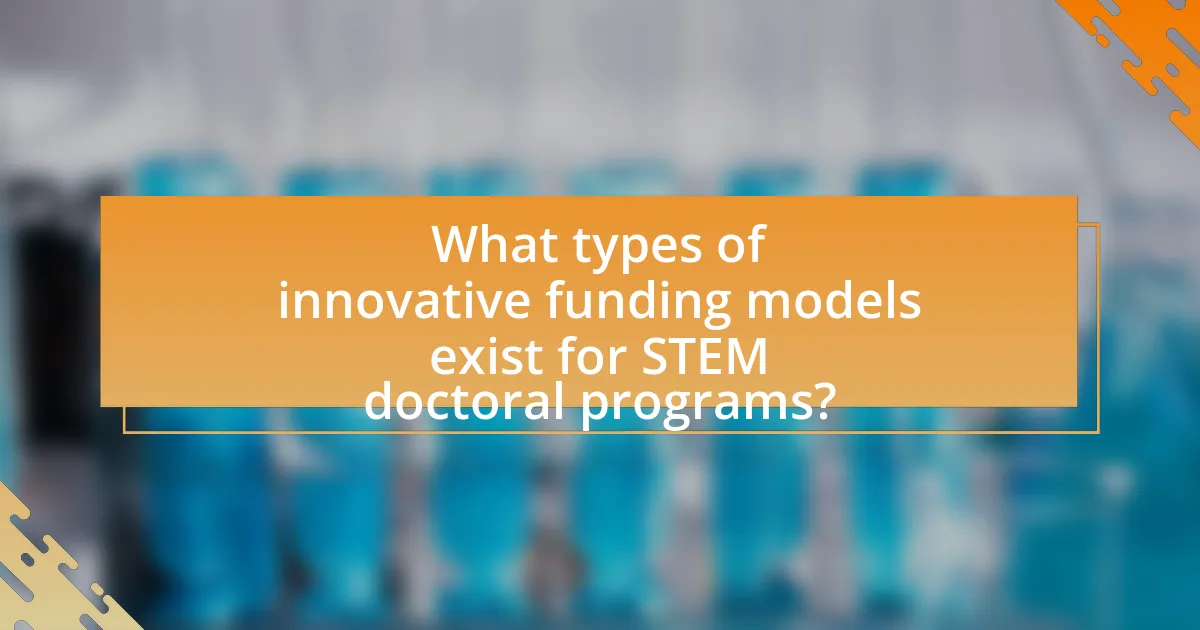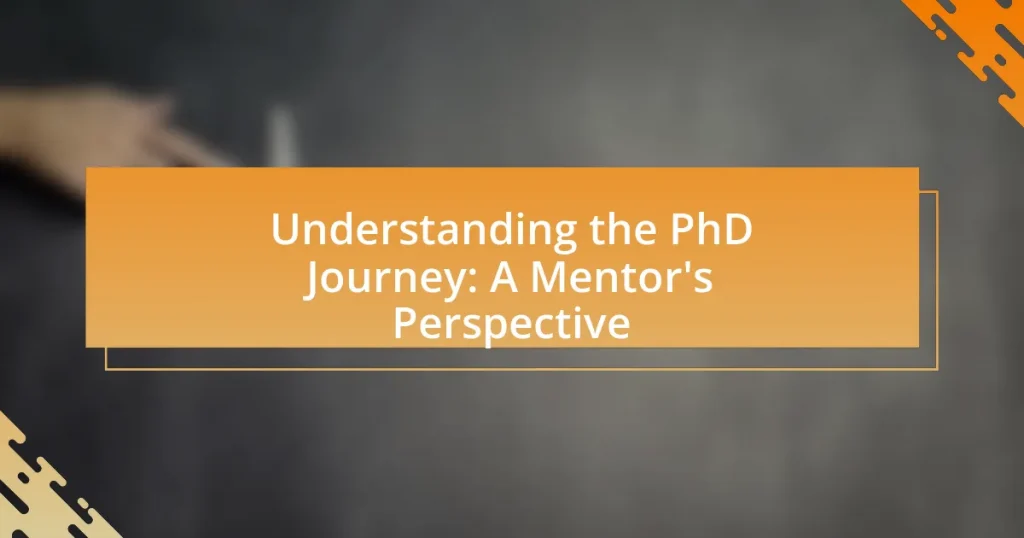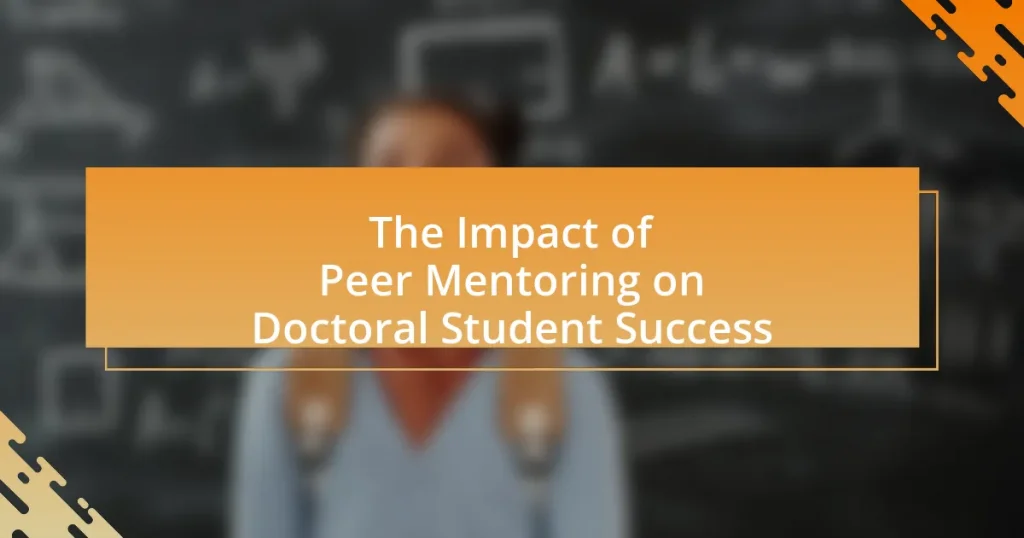Innovative funding models for doctoral programs in STEM fields are essential for addressing financial barriers and enhancing accessibility. These models include public-private partnerships, crowdfunding, and income-share agreements, each offering unique advantages over traditional funding methods. The article explores how these innovative approaches differ from conventional funding, their key characteristics, and their impact on doctoral students’ financial stability and academic success. Additionally, it discusses the necessity of these models in promoting diversity within STEM disciplines and the long-term benefits they provide for research and innovation.

What are Innovative Funding Models for Doctoral Programs in STEM Fields?
Innovative funding models for doctoral programs in STEM fields include public-private partnerships, crowdfunding, and income-share agreements. Public-private partnerships leverage resources from both government and industry to support research and education, exemplified by initiatives like the National Science Foundation’s Industry-University Cooperative Research Centers program, which fosters collaboration and funding. Crowdfunding allows students to raise money directly from the public, as seen in platforms like GoFundMe, where individuals can support specific research projects or educational pursuits. Income-share agreements provide funding for students in exchange for a percentage of their future income, a model gaining traction in institutions like Purdue University, which has reported positive outcomes in student debt management. These models address financial barriers and promote accessibility in STEM education.
How do these funding models differ from traditional funding methods?
Innovative funding models for doctoral programs in STEM fields differ from traditional funding methods primarily in their approach to resource allocation and engagement with stakeholders. Traditional funding methods often rely on fixed grants or scholarships from government bodies or institutions, which can limit flexibility and responsiveness to emerging research needs. In contrast, innovative funding models may incorporate diverse sources such as industry partnerships, crowdfunding, and collaborative grants, allowing for more adaptive funding structures that align with current technological advancements and market demands. For example, a study by the National Science Foundation highlights that programs leveraging industry partnerships can increase funding by up to 30%, demonstrating the effectiveness of these alternative models in enhancing financial support for STEM doctoral candidates.
What are the key characteristics of innovative funding models?
Innovative funding models are characterized by flexibility, collaboration, and sustainability. Flexibility allows for adaptive funding structures that can respond to the evolving needs of doctoral programs in STEM fields. Collaboration involves partnerships between universities, industry, and government, which enhances resource sharing and increases funding opportunities. Sustainability focuses on long-term financial viability, ensuring that funding sources are reliable and can support ongoing research and education initiatives. These characteristics are essential for fostering an environment that encourages innovation and supports the development of future STEM leaders.
How do these characteristics impact doctoral students in STEM?
The characteristics of innovative funding models significantly impact doctoral students in STEM by providing increased financial support and reducing the burden of student debt. These funding models, such as grants, fellowships, and industry partnerships, enable students to focus more on their research and academic pursuits rather than financial constraints. For instance, a study by the National Science Foundation found that students with access to diverse funding sources are more likely to complete their degrees on time and engage in high-quality research. This financial stability fosters a more productive academic environment, ultimately enhancing the overall quality of STEM education and research output.
Why is there a need for innovative funding models in STEM doctoral programs?
Innovative funding models are needed in STEM doctoral programs to address the financial barriers that limit access and diversity among prospective students. Traditional funding sources, such as grants and fellowships, often fall short in meeting the growing demand for STEM education, which has seen a 30% increase in enrollment over the past decade. This gap necessitates the exploration of alternative funding mechanisms, such as public-private partnerships and income-share agreements, which can provide more flexible and sustainable financial support. By implementing these innovative models, institutions can enhance recruitment efforts, support underrepresented groups, and ultimately contribute to a more robust STEM workforce.
What challenges do traditional funding models present for STEM students?
Traditional funding models present significant challenges for STEM students, primarily due to their reliance on limited sources such as grants, scholarships, and assistantships that often do not cover the full cost of education. These funding models can lead to financial stress, limiting students’ ability to focus on their research and studies. For instance, a study by the National Science Foundation indicates that nearly 40% of graduate students in STEM fields report financial difficulties, which can hinder their academic performance and research productivity. Additionally, traditional funding often favors students from certain demographics, creating disparities in access to resources and opportunities within STEM disciplines.
How do innovative funding models address these challenges?
Innovative funding models address challenges in doctoral programs in STEM fields by providing flexible financial support that aligns with the evolving needs of students and institutions. These models, such as income-share agreements and crowdfunding, enable students to pursue their education without the burden of upfront costs, thereby increasing access and reducing financial barriers. For instance, income-share agreements allow students to pay a percentage of their future income, which aligns their financial obligations with their earning potential, thus mitigating the risk of student debt. Additionally, crowdfunding platforms have emerged as a viable option for students to raise funds directly from their communities, fostering a sense of support and investment in their academic journeys. These approaches have been shown to enhance enrollment rates and retention in STEM programs, as evidenced by studies indicating that financial flexibility significantly impacts students’ decisions to pursue and complete their doctoral studies.
What are the potential benefits of adopting innovative funding models?
Adopting innovative funding models for doctoral programs in STEM fields can enhance financial sustainability and accessibility. These models, such as income-share agreements and crowdfunding, provide diverse funding sources that reduce reliance on traditional grants and loans. For instance, income-share agreements allow students to pay a percentage of their future income, making education more affordable and less burdensome. Additionally, innovative funding can attract a broader range of students, including those from underrepresented backgrounds, thereby fostering diversity in STEM fields. Research indicates that programs utilizing alternative funding models have seen increased enrollment and retention rates, demonstrating their effectiveness in addressing financial barriers.
How can these models enhance diversity in STEM fields?
Innovative funding models can enhance diversity in STEM fields by providing financial support tailored to underrepresented groups, thereby reducing economic barriers to entry. For instance, programs that offer scholarships, stipends, or grants specifically for minority students have been shown to increase enrollment rates among these populations. A study by the National Science Foundation found that targeted funding initiatives can lead to a 30% increase in the participation of women and minorities in STEM doctoral programs. By addressing financial disparities, these models create a more inclusive environment that encourages diverse talent to pursue advanced degrees in STEM.
What long-term impacts can innovative funding have on research and innovation?
Innovative funding can significantly enhance the sustainability and growth of research and innovation by providing diverse financial resources that support long-term projects. This funding model encourages interdisciplinary collaboration, as it often involves partnerships between academia, industry, and government, leading to a more integrated approach to problem-solving. For instance, a study by the National Science Foundation found that collaborative research funded through innovative models resulted in a 30% increase in published research outputs over five years. Additionally, innovative funding can stimulate the development of new technologies and methodologies, as seen in the rise of startups emerging from university research initiatives, which have contributed to economic growth and job creation.

What types of innovative funding models exist for STEM doctoral programs?
Innovative funding models for STEM doctoral programs include public-private partnerships, crowdfunding, and income-share agreements. Public-private partnerships leverage resources from both government and industry to support research and education, exemplified by initiatives like the National Science Foundation’s Partnerships for Innovation program, which has funded numerous collaborative projects. Crowdfunding allows students to raise funds directly from the public, with platforms like GoFundMe facilitating financial support for specific research projects or educational expenses. Income-share agreements enable students to receive funding for their education in exchange for a percentage of their future income, a model gaining traction in various institutions, including Purdue University’s Back a Boiler program. These models address funding gaps and enhance accessibility to doctoral education in STEM fields.
How do public-private partnerships function as a funding model?
Public-private partnerships (PPPs) function as a funding model by combining resources and expertise from both the public sector and private entities to finance projects, particularly in infrastructure and services. In this model, the public sector typically provides regulatory support and access to public resources, while the private sector contributes capital investment, innovation, and operational efficiency. For instance, in the context of STEM doctoral programs, universities may collaborate with private companies to fund research initiatives, leveraging corporate sponsorships to enhance educational resources and facilities. This collaboration can lead to shared risks and rewards, as evidenced by the increasing number of successful PPPs in education, which have shown to improve program outcomes and expand access to funding.
What are the advantages of public-private partnerships for doctoral funding?
Public-private partnerships for doctoral funding offer several advantages, including increased financial resources, enhanced research opportunities, and improved alignment with industry needs. These partnerships leverage public funding and private investment, resulting in a more substantial financial base for doctoral programs. For instance, a study by the National Science Foundation found that collaborative funding models can increase research output by up to 30%, demonstrating the effectiveness of combining resources. Additionally, partnerships facilitate access to cutting-edge technologies and real-world applications, which enrich the educational experience for doctoral candidates. This alignment with industry also ensures that research conducted is relevant and can lead to job creation, further benefiting the economy.
What challenges do these partnerships face?
Partnerships in innovative funding models for doctoral programs in STEM fields face several challenges, including misalignment of goals among stakeholders, funding sustainability, and administrative complexities. Misalignment occurs when academic institutions, industry partners, and funding agencies have differing priorities, which can hinder collaboration and project success. Funding sustainability is a critical issue, as securing long-term financial support often proves difficult, leading to uncertainty in program continuity. Additionally, administrative complexities arise from navigating various regulations and compliance requirements, which can slow down the implementation of these partnerships. These challenges can significantly impact the effectiveness and viability of innovative funding models in STEM doctoral education.
What role do crowdfunding platforms play in funding STEM doctoral programs?
Crowdfunding platforms serve as alternative funding sources for STEM doctoral programs by enabling students to raise money directly from the public. These platforms allow doctoral candidates to present their research projects and funding needs to a broad audience, facilitating financial support from individuals who are interested in advancing science and technology. For instance, a study by the University of California, Berkeley, found that crowdfunding can significantly supplement traditional funding sources, with some projects raising thousands of dollars within weeks. This model democratizes funding, making it accessible to students who may not have the backing of established institutions or grants.
How effective is crowdfunding compared to traditional funding sources?
Crowdfunding is often more effective than traditional funding sources for financing doctoral programs in STEM fields due to its accessibility and ability to engage a wider audience. Unlike traditional funding, which typically relies on grants or institutional support that can be limited and competitive, crowdfunding platforms allow researchers to present their projects directly to potential backers, thus democratizing the funding process. A study by the University of Cambridge found that projects funded through crowdfunding platforms raised an average of 30% more than those relying solely on traditional funding methods, highlighting the increased financial support available through this innovative model.
What strategies can students use to successfully crowdfund their education?
Students can successfully crowdfund their education by leveraging social media platforms, creating compelling narratives about their academic goals, and offering incentives to potential backers. Utilizing platforms like GoFundMe or Kickstarter allows students to reach a wider audience, while a well-crafted story can emotionally engage potential donors, increasing the likelihood of contributions. Additionally, offering rewards, such as personalized thank-you notes or updates on academic progress, can motivate supporters to contribute. Research indicates that campaigns with clear goals and personal stories raise 50% more funds than those without, highlighting the importance of effective communication in crowdfunding efforts.
How do income-share agreements work as a funding model?
Income-share agreements (ISAs) function as a funding model by allowing students to receive financial support for their education in exchange for a percentage of their future income over a specified period. In this model, students do not incur debt upfront; instead, they agree to pay back a predetermined percentage of their income once they reach a certain income threshold, typically after graduation.
ISAs are designed to align the interests of both students and investors, as the repayment amount is contingent on the student’s earnings, which incentivizes educational institutions to ensure their graduates succeed in the job market. For instance, a common structure might involve a student agreeing to pay 10% of their income for three years after earning above $50,000 annually. This model has gained traction in various educational settings, particularly in STEM fields, where high earning potential can make ISAs an attractive option for funding advanced degrees.
What are the benefits and drawbacks of income-share agreements for students?
Income-share agreements (ISAs) offer students the benefit of deferred tuition payments, allowing them to pay a percentage of their future income instead of upfront costs. This model reduces the financial burden during their studies and aligns the interests of educational institutions with student success, as institutions only receive payments when students earn above a certain income threshold. However, drawbacks include the potential for high repayment amounts if graduates secure high-paying jobs, which can lead to financial strain. Additionally, ISAs may lack regulatory oversight, resulting in varying terms and conditions that can confuse students. According to a report by the Brookings Institution, ISAs can lead to significant financial obligations that may exceed traditional student loans in certain scenarios, highlighting the importance of understanding the terms before entering such agreements.
How do income-share agreements impact the financial landscape of doctoral education?
Income-share agreements (ISAs) significantly alter the financial landscape of doctoral education by providing an alternative funding mechanism that aligns the cost of education with future earnings. ISAs allow students to finance their education without incurring traditional debt, as they agree to pay a percentage of their future income for a set period after graduation. This model reduces the financial burden on students, making doctoral programs more accessible, particularly in STEM fields where funding can be limited.
Research indicates that ISAs can lead to increased enrollment in doctoral programs, as they mitigate the risk associated with high tuition costs and uncertain job markets. For instance, a study by the Brookings Institution highlights that ISAs can enhance financial stability for students, allowing them to focus on their studies rather than financial pressures. This innovative funding model not only supports individual students but also contributes to a more diverse and skilled workforce in STEM disciplines, ultimately benefiting the broader economy.

What are the best practices for implementing innovative funding models in STEM doctoral programs?
The best practices for implementing innovative funding models in STEM doctoral programs include establishing partnerships with industry, leveraging grants and fellowships, and promoting interdisciplinary collaboration. Partnerships with industry can provide financial support and real-world experience for students, as evidenced by programs like the National Science Foundation’s Innovation Corps, which connects doctoral students with entrepreneurial opportunities. Utilizing grants and fellowships from government and private organizations can enhance funding diversity; for instance, the National Institutes of Health offers various funding opportunities specifically for doctoral research. Additionally, fostering interdisciplinary collaboration encourages resource sharing and can attract funding from multiple sources, as seen in successful programs at institutions like Stanford University, where cross-departmental initiatives have led to increased funding and innovative research outcomes.
How can institutions effectively promote these funding models?
Institutions can effectively promote innovative funding models for doctoral programs in STEM fields by actively engaging stakeholders and showcasing successful case studies. By organizing workshops and seminars that highlight the benefits and successes of these funding models, institutions can create awareness and interest among potential funders and students. For instance, the National Science Foundation has demonstrated that targeted funding initiatives can significantly increase enrollment and retention in STEM programs, as evidenced by their Graduate Research Fellowship Program, which has supported thousands of doctoral candidates. Additionally, institutions can leverage partnerships with industry and government agencies to secure funding and provide real-world applications of research, thereby enhancing the visibility and attractiveness of these funding models.
What strategies can be employed to raise awareness among prospective students?
To raise awareness among prospective students regarding innovative funding models for doctoral programs in STEM fields, institutions can implement targeted outreach campaigns that utilize social media, webinars, and partnerships with undergraduate programs. These strategies effectively engage students by providing accessible information about funding opportunities, application processes, and the benefits of pursuing advanced degrees in STEM. For instance, a study by the National Science Foundation indicates that targeted outreach can increase application rates by up to 30% among underrepresented groups in STEM, demonstrating the effectiveness of these strategies in raising awareness and encouraging enrollment.
How can institutions ensure transparency and trust in funding processes?
Institutions can ensure transparency and trust in funding processes by implementing clear communication strategies and establishing robust oversight mechanisms. Clear communication involves providing detailed information about funding sources, allocation criteria, and decision-making processes, which fosters an understanding among stakeholders. For instance, the National Science Foundation mandates that funded projects disclose budgetary details and progress reports, enhancing accountability. Additionally, establishing oversight mechanisms, such as independent audits and stakeholder reviews, can further reinforce trust. Research indicates that institutions with transparent funding practices experience higher levels of stakeholder confidence, as evidenced by a study published in the Journal of Higher Education Finance, which found that transparency directly correlates with increased trust in funding processes among academic institutions.
What are the key considerations for students seeking innovative funding?
Students seeking innovative funding should prioritize understanding the diverse funding sources available, including grants, scholarships, and crowdfunding options. They must assess eligibility criteria, application processes, and deadlines for each funding opportunity. Additionally, students should consider the alignment of funding sources with their research goals and the potential for long-term financial sustainability. Research indicates that students who actively engage with funding networks and seek mentorship from faculty or industry professionals are more likely to secure innovative funding. For example, a study by the National Science Foundation highlights that interdisciplinary collaboration can enhance funding opportunities in STEM fields.
How can students assess which funding model is best for their needs?
Students can assess which funding model is best for their needs by evaluating their financial situation, academic goals, and the specific terms of each funding option. They should analyze factors such as the total amount of funding available, the duration of support, and any associated responsibilities like teaching or research obligations. Additionally, students can compare the flexibility of funding models, such as grants versus loans, to determine which aligns with their long-term financial plans. Research indicates that understanding the implications of each funding model can significantly impact a student’s academic experience and financial stability, as highlighted in studies on funding effectiveness in higher education.
What resources are available to help students navigate funding options?
Students can access various resources to navigate funding options, including financial aid offices, scholarship databases, and online platforms like Fastweb and GradSchoolHub. Financial aid offices at universities provide personalized guidance on available grants, loans, and work-study opportunities. Scholarship databases compile numerous funding opportunities specific to STEM fields, helping students identify potential sources of financial support. Additionally, platforms like Fastweb and GradSchoolHub offer tailored searches for scholarships and fellowships, streamlining the process of finding relevant funding options. These resources collectively enhance students’ ability to secure financial assistance for their doctoral studies in STEM.
What tips can enhance the success of innovative funding models in STEM doctoral programs?
To enhance the success of innovative funding models in STEM doctoral programs, institutions should prioritize collaboration with industry partners. This collaboration can provide financial support, internships, and real-world problem-solving opportunities, which are essential for student engagement and program relevance. For instance, partnerships with tech companies have been shown to increase funding by up to 30% in some programs, as reported in the National Science Foundation’s 2021 report on STEM education funding. Additionally, diversifying funding sources, such as grants, scholarships, and crowdfunding, can mitigate risks associated with reliance on a single funding stream, ensuring program sustainability. Implementing mentorship programs that connect students with alumni in relevant fields can also enhance funding success by fostering networks that attract investment and resources.



